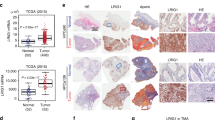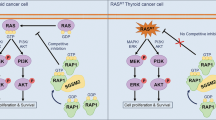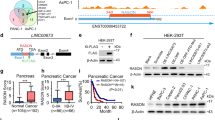Abstract
The thyroid hormone receptor (TR) is a suppressor of ras-mediated responses. To characterize the receptor domains involved in this function, we analyzed a panel of TRβ1 mutants for their ability to interfere with ras-driven cyclin D1 activation, formation of transformation foci and tumor growth in nude mice. Our results show that the domains and mechanisms responsible for the anti-transforming and anti-tumorigenic actions of the receptor are divergent from those operating in classical T3-dependent transcriptional activation. TRβ1 mutants that do not bind coactivators and do not transactivate retained the capacity of suppressing cellular transformation and tumor growth, whereas selective mutations in the hinge region affecting corepressors recruitment abolished these actions, while preserving ligand-dependent transcription. There was a strict parallelism between anti-transforming activity of the various mutants and their ability to antagonize cyclin D1 stimulation by ras, indicating that transrepression mechanisms may have an important function in suppression of the transforming effects of the oncogene by TRβ1. The inhibitory action of T3 on transformation was further enhanced after over-expression of corepressors, while corepressor depletion by means of small-interference RNA reversed significantly hormonal action. This shows an important functional role of endogenous corepressors in suppression of ras-mediated transformation and tumorigenesis by TRβ1
This is a preview of subscription content, access via your institution
Access options
Subscribe to this journal
Receive 50 print issues and online access
$259.00 per year
only $5.18 per issue
Buy this article
- Purchase on Springer Link
- Instant access to full article PDF
Prices may be subject to local taxes which are calculated during checkout









Similar content being viewed by others
References
Anjum R, Blenis J . (2008). The RSK family of kinases: emerging roles in cellular signalling. Nat Rev Mol Cell Biol 9: 747–758.
Aranda A, Pascual A . (2001). Nuclear hormone receptors and gene expression. Physiol Rev 81: 1269–1304.
Aranda A, Martínez-Iglesias O, Ruiz-Llorente L, García-Carpizo V, Zambrano A . (2009). Thyroid receptor: roles in cancer. Trends Endocrinol Metab 20: 319–324.
Berghagen H, Ragnhildstveit E, Krogsrud K, Thuestad G, Apriletti J, Saatcioglu F . (2002). Corepressor SMRT functions as a coactivator for thyroid hormone receptor T3Ralpha from a negative hormone response element. J Biol Chem 277: 49517–49522.
Bos JL . (1989). ras oncogenes in human cancer: a review. Cancer Res 49: 4682–4689.
Campbell SL, Khosravi-Far, Rossman KL, Clark GJ, Der CJ . (1998). Increasing complexity of Ras signaling. Oncogene 17: 1395–1413.
Castillo AI, Sanchez-Martinez R, Moreno JL, Martinez-Iglesias OA, Palacios D, Aranda A . (2004). A permissive retinoid X receptor/thyroid hormone receptor heterodimer allows stimulation of prolactin gene transcription by thyroid hormone and 9-cis-retinoic acid. Mol Cell Biol 24: 502–513.
Chan IH, Privalsky ML . 2006. Thyroid hormone receptors mutated in liver cancer function as distorted antimorphs. Oncogene 25: 3576–3588.
Damm K, Beug H, Graf T, Vennström B . (1987). A single point mutation in erbA restores the erythroid transforming potency of a mutant avian erythroblastosis virus (AEV) defective in both erbA and erbB oncogenes. EMBO J 6: 675–682.
De Bosscher K, Van Craenenbroeck K, Meijer OC, Haegeman G . (2008). Selective transrepression versus transactivation mechanisms by glucocorticoid receptor modulators in stress and immune systems. Eur J Pharmacol 583: 290–302.
Feng W, Ribeiro RC, Wagner RL, Nguyen H, Apriletti JW, Fletterick RJ et al. (1998). Hormone-dependent coactivator binding to a hydrophobic cleft on nuclear receptors. Science 280: 1747–1749.
Fernandez-Majada V, Pujadas J, Vilardell F, Capella G, Mayo MW, Bigas A et al. (2007). Aberrant cytoplasmic localization of N-CoR in colorectal tumors. Cell Cycle 6: 1748–1752.
Filmus J, Robles AI, Shi W, Wong MJ, Colombo LL, Conti CJ . (1994). Induction of cyclin D1 overexpression by activated ras. Oncogene 9: 3627–3633.
Flamant F, Baxter JD, Forrest D, Refetoff S, Samuels H, Scanlan TS et al. (2006). International Union of Pharmacology. LIX. The pharmacology and classification of the nuclear receptor superfamily: thyroid hormone receptors. Pharmacol Rev 58: 705–711.
Furumoto H, Ying H, Chandramouli GV, Zhao L, Walker RL, Meltzer PS et al. (2005). An unliganded thyroid hormone beta receptor activates the cyclin D1/cyclin-dependent kinase/retinoblastoma/E2F pathway and induces pituitary tumorigenesis. Mol Cell Biol 25: 124–135.
Furuya F, Lu C, Guigon CJ, Cheng SY . (2009). Nongenomic activation of phosphatidylinositol 3-kinase signaling by thyroid hormone receptors. Steroids 74: 628–634.
Garcia-Silva S, Aranda A . (2004). The thyroid hormone receptor is a suppressor of ras-mediated transcription, proliferation, and transformation. Mol Cell Biol 24: 7514–7523.
Hong SH, Yang Z, Privalsky ML . (2001). Arsenic trioxide is a potent inhibitor of the interaction of SMRT corepressor with its transcription factor partners, including the PML-retinoic acid receptor alpha oncoprotein found in human acute promyelocytic leukemia. Mol Cell Biol 21: 7172–7182.
Hörlein AJ, Näär AM, Heinzel T, Torchia J, Gloss B, Kurokawa R et al. (1995). Ligand-independent repression by the thyroid hormone receptor mediated by a nuclear receptor co-repressor. Nature 377: 397–404.
Ito Y, Sasaki Y, Horimoto M, Wada S, Tanaka Y, Kasahara A et al. (1998). Activation of mitogen-activated protein kinases/extracellular signal-regulated kinases in human hepatocellular carcinoma. Hepatology 27: 951–958.
Lavinsky RM, Jepsen K, Heinzel T, Torchia J, Mullen TMG, Schiff R et al. (1998). Diverse signaling pathways modulate nuclear receptor recruitment of N-CoR and SMRT complexes. Proc Natl Acad Sci USA 95: 2920–2925.
Lazar MA . (2003). Nuclear receptor corepressors. Nucl Recept Signal 1: e001.
Liu JJ, Chao JR, Jiang MC, Ng SY, Yen JJ, Yang-Yen HF . (1995). Ras transformation results in an elevated level of cyclin D1 and acceleration of G1 progression in NIH 3T3 cells. Mol Cell Biol 15: 3654–3663.
Lowy DR, Willumsen BM . (1993). Function and regulation of ras. Annu Rev Biochem 62: 851–891.
Marimuthu A, Feng W, Tagami T, Nguyen H, Jameson JL, Fletterick RJ et al. (2002). TR surfaces and conformations required to bind nuclear receptor corepressor. Mol Endocrinol 16: 271–286.
Martínez-Iglesias O, García-Silva S, Tenbaun SP, Regadera J, Larcher F, Paramio JM et al. (2009a). The thyroid hormone receptor beta1 acts as a potent suppressor of tumor invasiveness and metastasis. Cancer Res 69: 501–509.
Martínez-Iglesias O, García-Silva S, Regadera J, Aranda A . (2009b). Hypothyroidism enhances tumor invasiveness and metastasis development. PLoS One 4: e6428.
Meier CA, Dickstein BM, Ashizawa K, McClaskey JH, Muchmore P, Ransom SC et al. (1992). Variable transcriptional activity and ligand binding of mutant beta 1 3,5,3’-triiodothyronine receptors from four families with generalized resistance to thyroid hormone. Mol Endocrinol 6: 248–258.
Mendez-Pertuz M, Sanchez-Pacheco A, Aranda A . (2003). The thyroid hormone receptor antagonizes CREB-mediated transcription. EMBO J 22: 3102–3112.
Pascual G, Glass CK . (2006). Nuclear receptors versus inflammation: mechanisms of transrepression. Trends Endocrinol Metab 17: 321–327.
Perissi V, Staszewski LM, McInerney EM, Kurokawa R, Krones A, Rose DW et al. (1999). Molecular determinants of nuclear receptor-corepressor interaction. Genes Dev 13: 3198–3208.
Peterson TJ, Karmakar S, Pace MC, Gao T, Smith CL . (2007). The silencing mediator of retinoic acid and thyroid hormone receptor (SMRT) corepressor is required for full estrogen receptor alpha transcriptional activity. Mol Cell Biol 27: 5933–5948.
Pfahl M . (1993). Nuclear receptor/AP-1 interaction. Endocr Rev 14: 651–658.
Pissios P, Tzameli I, Kushner P, Moore DD . (2000). Dynamic stabilization of nuclear receptor ligand binding domains by hormone or corepressor binding. Mol Cell 6: 245–253.
Privalsky ML . (2004). The role of corepressors in transcriptional regulation by nuclear hormone receptors. Annu Rev Physiol 66: 315–360.
Robles AI, Rodriguez-Puebla ML, Glick AB, Trempus C, Hansen L, Sicinski P et al. (1998). Reduced skin tumor development in cyclin D1-deficient mice highlights the oncogenic ras pathway in vivo. Genes Dev 12: 2469–2474.
Rogatsky I, Zarember KA, Yamamoto KR . (2001). Factor recruitment and TIF2/GRIP1 corepressor activity at a collagenase-3 response element that mediates regulation by phorbol esters and hormones. EMBO J 20: 6071–6083.
Safer JD, Cohen RN, Hollenberg AN, Wondisford FE . (1998). Defective release of corepressor by hinge mutants of the thyroid hormone receptor found in patients with resistance to thyroid hormone. J Biol Chem 273: 30175–30182.
Sanchez-Martinez R, Castillo AI, Steinmeyer A, Aranda A . (2006). The retinoid X receptor ligand restores defective signalling by the vitamin D receptor. EMBO Rep 10: 1030–1034.
Song L, Zlobin A, Ghoshal P, Zhang Q, Houde C, Weijzen S et al. (2005). Alteration of SMRT tumor suppressor function in transformed non-Hodgkin lymphomas. Cancer Res 65: 4554–4561.
Suzuki H, Willingham MC, Cheng SY . (2002). Mice with a mutation in the thyroid hormone receptor beta gene spontaneously develop thyroid carcinoma: a mouse model of thyroid carcinogenesis. Thyroid 12: 963–969.
Tagami T, Madison LD, Nagaya T, Jameson JL . (1997). Nuclear receptor corepressors activate rather than suppress basal transcription of genes that are negatively regulated by thyroid hormone. Mol Cell Biol 17: 2642–2648.
Xing J, Ginty DD, Greenberg ME . (1996). Coupling of the RAS-MAPK pathway to gene activation by RSK2, a growth factor-regulated CREB kinase. Science 273: 959–963.
Yen PM . (2001). Physiological and molecular basis of thyroid hormone action. Physiol Rev 81: 1097–1142.
Zhu XG, Zhao L, Willingham MC, Cheng SY . (2010). Thyroid hormone receptors are tumor suppressors in a mouse model of metastatic follicular thyroid carcinoma. Oncogene 29: 1909–1919.
Acknowledgements
We are grateful to M Sánchez-Prieto and PA Chávez for technical help and to A Zambrano for TR mutants. This work was supported by Grant BFU2007–62402 from Ministerio de Educación y Ciencia, RD06/0020/0036 and Acción Transversal de Cáncer from the Fondo de Investigaciones Sanitarias and by the European Grant CRESCENDO (FP-018652).
Author information
Authors and Affiliations
Corresponding author
Ethics declarations
Competing interests
The authors declare no conflict of interest.
Additional information
Supplementary Information accompanies the paper on the Oncogene website
Supplementary information
Rights and permissions
About this article
Cite this article
García-Silva, S., Martínez-Iglesias, O., Ruiz-Llorente, L. et al. Thyroid hormone receptor β1 domains responsible for the antagonism with the ras oncogene: role of corepressors. Oncogene 30, 854–864 (2011). https://doi.org/10.1038/onc.2010.464
Received:
Revised:
Accepted:
Published:
Issue Date:
DOI: https://doi.org/10.1038/onc.2010.464
Keywords
This article is cited by
-
Overexpression of modified human TRβ1 suppresses the growth of hepatocarcinoma SK-hep1 cells in vitro and in xenograft models
Molecular and Cellular Biochemistry (2018)
-
Thyroid hormone actions in liver cancer
Cellular and Molecular Life Sciences (2013)
-
Lost expression of thyroid hormone receptor-β1 mRNA in esophageal cancer
Frontiers in Biology (2012)



